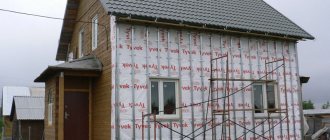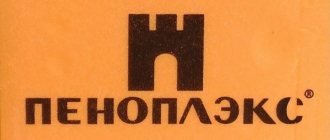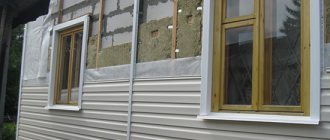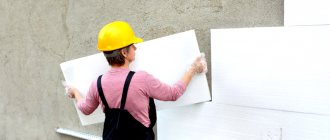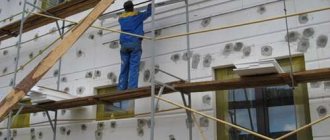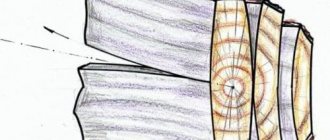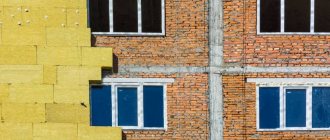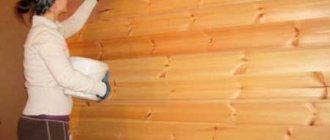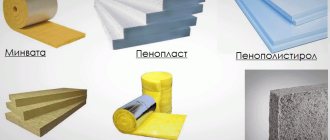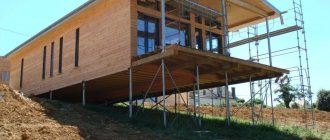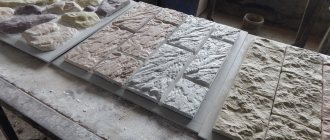SHARE ON SOCIAL NETWORKS
FacebookTwitterOkGoogle+PinterestVk
High-quality home insulation is the key to a comfortable life in the cold season. Therefore, to avoid being disturbed by frost in winter, you should think about the choice of material and insulation technology in advance. This applies to all cases, including insulating a wooden house from the outside. Let's consider what you should pay attention to when choosing a suitable material, as well as how to do everything you need yourself if we are talking about a building made of wood.
Insulation of the facade of a wooden house must be carried out before the onset of cold weather.
Insulating a wooden house from the outside: the most common materials
There are a lot of thermal insulation materials. Some of them are very popular among consumers, while others, on the contrary, are used quite rarely. Let's look at what characteristics determine popularity and which options are used most often:
- stone wool in slabs is a lightweight and convenient material that can be easily transported and can be cut even with a regular knife. These slabs are laid between the frame elements and then covered with vapor barrier and waterproofing material on different sides. The main thing is not to compress or compact the mats while transporting them, as they are easily deformed;
Various materials can be used as insulation materials, such as mineral wool, polystyrene foam, ecowool and the like.
- ecowool is a material created on the basis of cellulose, which is compressed and packaged. For insulation with its help, you can use two options. In the first case, I take the cotton wool out of the open package, knead it slightly, and press it into the walls. It is difficult to say unequivocally how good this method is. Some manufacturers claim that with such insulation you will not have problems for 10 to 20 years. Although it is impossible to completely deny the possibility of shrinkage and deterioration of the thermal insulation properties of the material. The second method is called wet, since ecowool is sprayed onto the walls, due to which the material adheres to the frame and the risk of subsidence is eliminated;
- polystyrene foam is a very common and cheap way to insulate a building. Its low cost is due to its fragility, brittleness, as well as the need to additionally cover it with a moisture-proof membrane in order to avoid the accumulation of condensation in the future. It is important that for insulation you need to buy only unpressed sheets of polystyrene foam;
- polyurethane foam is a material consisting of two separate components mixed together under high pressure. When it comes into contact with air, it behaves in the same way as regular polyurethane foam - it expands. Insulating a wooden house with polyurethane foam is quite effective and reduces heat loss to a minimum. In addition, polyurethane foam has the ability to repel water;
- insulation materials of natural origin are various mixtures and slabs made from sawdust, straw, clay, etc. The cost of this method is low, but when choosing this option, you need to be prepared to tinker. One of the easy-to-use natural insulation materials is, perhaps, flax fibers.
All materials used for wall insulation are manufactured as environmentally friendly and harmless to human health.
What is the best way to insulate?
A house with a long service life requires not only insulation of the facade, but also all structural elements as a whole. Such actions will help to more effectively retain heat inside the house. Therefore, we will consider all the elements separately:
Wall insulation
It is better to insulate the walls from the outside. This shifts the dew point towards the environment, allowing it to be removed from the substrate much faster. If you insulate the walls from the inside, you can cause a completely opposite result. In this case, the walls will still freeze.
To insulate the walls, we choose hard mineral wool mats. If you have the financial means, you can take the foil version. A layer of foil will reflect heat from the walls. Before installing the insulation, be sure to close all cracks.
In this case, we use a tourniquet, dry moss or tow. With this material we tightly seal the inter-crown space or cracks that may form on the logs.
Ceiling
You can insulate the ceiling in two ways:
- from the side of the room;
- from the attic side.
Both the first and second methods are effective. More rigid materials are laid on the ceiling. If there is an attic under the roof, then it is better to resort to insulation from the side of the rooms. Then a structure is created from beams, between which sheet insulation is placed. Don't forget about vapor barrier membranes.
When there is an attic under the roof, you can use mineral wool and even polystyrene foam. A more rigid material must be laid on top of the insulation. This can be chipboard slabs, which will protect the insulation from being pressed through.
There is an option when bulk insulation is used, for example, sawdust, gravel. But you need a lot of such materials, which can be even more expensive than using modern insulation.
Floor
The choice of insulation technology for a dilapidated house depends on whether there is a basement or not. If there is a basement, then first insulate it. There may be no need to further insulate the floor after this.
But if such a need has already been determined, then choose the following options:
- Laying heated floors (electric heating). Not always suitable for old wooden structures, as it requires reliable electrical wiring.
- Use of thermal insulation materials. They choose only hard options, but be sure to make a plank floor or cover it with chipboard or OSB, and then decorate it with the selected flooring material.
It is in an old wooden house that large heat losses occur due to dilapidated floors. Therefore, you should not neglect the possibility of insulating floors. More precisely, start insulating the house from the floors.
Other materials used for external insulation of house walls
In addition to traditional materials, there are several more options that, although they have not yet gained such popularity, still often surpass the characteristics of those already considered.
- Basalt slabs for facade insulation. The price is the only drawback that can be found in this material. Despite its similarity with mineral wool, this material is many times superior to it in terms of technical indicators and characteristics. It provides excellent thermal insulation and at the same time is able to withstand heavy loads and temperature changes. Over time, it does not shrink and does not lose its characteristics. So its considerable cost, in comparison with other materials, can be called more than justified.
- Penoplex is a material that is quickly gaining popularity, despite the fact that it has recently appeared on the market. The material is extruded polystyrene foam, characterized by low weight and good moisture resistance. This allows it to be used without laying additional waterproofing layers.
- “Arctic” insulation consists of synthetic fibers that are bonded together under the influence of hot air. The material is excellent for use in the harshest weather conditions. This insulation is considered breathable and provides good thermoregulation in both winter and summer.
Basalt slabs are similar in structure to mineral wool, but their characteristics are much superior to it
Helpful advice! When working with any type of insulation material, it is necessary to use personal protective equipment to prevent fibers from entering the respiratory tract and on the skin, as this can cause irritation.
Conclusion
You must decide on your own what is the best way to insulate the outside walls of your home. However, when choosing heat-insulating materials, you should definitely consider the following factors:
- resistance of the material to moisture, since the facade is exposed to atmospheric influences;
- non-flammability - choose a material containing fire retardants that prevent the spread of fire;
- ease of installation is an important quality that allows you to do the work yourself;
- high vapor permeability;
- degree of heat capacity;
- the price indicator is also not the least important.
The thermal insulation properties of polyurethane foam are equal to the properties of a brick wall 1 meter thick
All materials have different characteristics, which does not allow us to give a clear answer which one is better. The choice will depend on the characteristics of the building, as well as the quality and thickness of the walls. Each of the listed insulation materials has the right to exist and is capable of producing an effect when used correctly.
Advantages of external insulation of a wooden house over internal insulation
Choosing the right method for insulating a wooden house is the key to a quality result. Internal insulation of houses is used extremely rarely, since a thick layer of material will noticeably reduce the area of the room. In addition, insulating the walls in a wooden house from the inside will lead to the fact that the outer side of the walls will still be exposed to cold, which will lead to freezing of the wood.
Improperly carried out work and non-compliance with the insulation technology of a frame house can lead to the fact that the tree begins to rot from the inside and becomes a favorable environment for the activity of fungi and mold. That is why the method is no less important than the choice of material suitable for this purpose.
It is better to carry out work on insulating a wooden house outside than inside
But when insulating externally, it is also important to ensure that vapors can escape freely. Otherwise, the wood will deteriorate and it will be impossible to control the condition of the walls.
No. 5. Polymer insulation
I wouldn’t dare recommend this group of materials for insulating a wooden house. Polymer materials do not breathe, which means that all the advantages of wooden walls go down the drain. When using such insulation, you will need a serious ventilation system. It is justified to use them when insulating concrete slabs and stone plinths.
Expanded polystyrene
It is popularly called polystyrene foam. The material consists of a mass of balls that are interconnected to form small cavities.
pros:
- low weight and ease of processing;
- good thermal conductivity (0.036-0.051 W/m*C)
- low price;
- durability;
- soundproofing.
The disadvantages are more significant:
- flammability;
- vapor tightness;
- Rodents love to make burrows in polystyrene foam;
- Water can accumulate in the cavities between the foam balls. The water absorption rate by volume for 24 hours is 2%, for 30 days – 4%. Not so much, but accumulated moisture during freezing can destroy the structure of the insulation.
Too much work will have to be done to protect the material from fire, rodents and moisture, and to provide ventilation in the house, so it is better not to insulate wooden walls in this way - the low price of polystyrene foam is not justified by other expenses.
Extruded polystyrene foam
This is a more advanced insulation material, a material related to foam plastic, but the production method is completely different, hence the difference in properties.
pros:
- low thermal conductivity (0.028-0.034 W/m*C). If the house is located beyond the Arctic Circle, then this is the best solution;
- light weight;
- ease of installation;
- moisture resistance;
- quite high strength.
The serious disadvantages are vapor resistance, flammability and high price.
PVC foam
The insulation is made on the basis of polyvinyl chloride (PVC). The result is a lightweight cellular material with an impressive range of advantages:
- high strength, higher than that of extruded polystyrene foam;
- low thermal conductivity coefficient (0.035-0.07 W/m*C)
- combustion resistance;
- good vapor permeability, the highest in this class of materials;
- biostability.
Everything would be fine if not for the price. The material is very expensive, and when burned, although it is prone to self-extinguishing, it releases hydrogen chloride, which, when combined with water, produces hydrochloric acid.
Features of the technology of facade insulation with mineral wool
When laying the thermal insulation layer, it is necessary to provide waterproofing to the walls. Glassine is excellent for this purpose. Despite its low cost, it does its job perfectly. Initially, you need to cut strips from it and secure them to the frame using a stapler. The step should not exceed 12 cm.
Glassine sheets are glued overlapping so that the overlap is about 10 cm. This helps prevent condensation from getting on the heat-insulating material.
Helpful advice! If, after insulating the house, you plan to cover it with siding, then you need to make sure that there is free space between it and the insulation (approximately 30-50 cm). This will not allow moisture to linger in the frame.
When the glassine is secured, you can proceed to laying the insulation. Mineral wool in this case is an excellent option, since it is not prone to fire and is easy to install. The main thing is that the thickness of mineral wool for insulating the walls is selected correctly. For a temperate climate, this figure should be 80-100 mm, and for regions with harsh winters, material with a thickness of 150 mm can be used.
Mineral wool is one of the most effective and economical materials for insulation
The technology for insulating facades with mineral wool provides for the following sequence of work:
- it is necessary to measure the distance between the posts;
- to the result obtained, add 5 cm to the allowance on each side;
- Using a sharp knife, we cut the mineral slabs for wall insulation to the required size and lay them on the wall on top of the waterproofing;
- The joints between the frame and the insulation are additionally covered with cut strips 3-4 cm wide.
A layer of vapor barrier material must be laid on top. Penophenol, which is attached to the frame using a construction stapler, is excellent. After this, all that remains is to cover the walls with siding or edged boards, depending on your desire, and you can consider the procedure of insulating a wooden house from the outside with mineral wool completed.
Helpful advice! Penophenol should be laid strictly in a horizontal direction, leaving 5 cm joints so that there is a foil part on the outside.
Step-by-step instruction
The procedure for insulating a wooden wall directly depends on the chosen insulation method.
Ventilated facade
When performing insulation using this method, you must clearly follow the sequence of actions :
- Preparing the walls. Includes cleaning the surface from rotten areas and treating mold.
- Formation of the sheathing. To install it you need to use slats.
- Laying insulation into the prepared frame. It is better to use eco or mineral wool as insulation.
- Construction of the second frame. It must be mounted perpendicular to the previous layer.
- Laying the next layer of insulation. It is necessary to ensure that the thermal insulation covers the seams of the previous layer.
- Membrane device. It should overlap the seams.
- Installation of counter battens.
- Installation of slabs.
Wet method
During the installation process it is necessary to perform a number of manipulations:
- Preparing the walls. Rub and restore cracks and cracks on the surface. If the surface is severely deformed, the base walls must be covered with fiberboard slabs.
- Priming the wall, applying a layer of plaster. The plaster is applied in a thin layer.
- Installation of load-bearing plinth. Its width should be similar to the insulation board. It is carried out in a horizontal plane, at a height of 40 cm from the ground. When installing the plinth, it is necessary to maintain a step of 3 mm.
- Installation of insulation boards.
Apply cement glue to the insulation: several piles in the center of the slab, a layer along the contour of the slab. If the wall is smooth, apply the solution evenly along the contour and level it with a spatula. Then glue the insulation to the wall. Vertical seams of insulation should be placed on different axes. It is necessary to maintain a distance of 20 cm between levels. At the corners, the material is laid out in a checkerboard pattern. - Leave the slabs to dry for 3 days.
- Additional fastening device. Secure the slabs at the corners and in the middle using special inserts.
- Installation of reinforcing mesh. The first layer is glued into the insulation, then the second layer of mesh is installed, then the plaster is applied.
- Finish coating.
Laying under cladding
The device technology in this case is carried out in several stages:
Using a tape measure and a level on the facade, mark the position of the timber used for the sheathing.
The step between the locations of the beams should be similar to the width of the insulation minus 1.5 cm. The cross-section of the beam should be similar to the thickness of the insulation.- Installation of thermal insulation into the prepared sheathing, securing it with dowels.
- Sealing insulation joints with butyl tape.
- Siding installation. After installing the finishing trim, there should be a gap of at least 5 cm.
When insulating with mineral wool, it is necessary to observe some nuances:
- Place the insulation end-to-end between the studs and fill the gaps with foam.
- When installing the second layer of insulation, it is necessary to attach counter-battens to the posts, and lay mineral wool between them.
- Attach a diffuse membrane to the frame.
- Install counter-lattice.
Spraying polyurethane foam
The process is carried out in the following sequence:
- Installation of wooden lathing on the wall with a distance of 30 cm.
- Apply foam starting from the bottom of the wall, gradually moving upward. The distance from the gun to the surface to be treated must be at least 20 cm.
- For smooth distribution of the composition, it is recommended to move the gun smoothly. When moving to a new location, the gun turns off.
- A new layer cannot be applied until the first layer has cured. The insulation should not protrude beyond the sheathing; this must be carefully monitored.
- Installation of reinforcing mesh, finishing.
Facade insulation with extruded polystyrene foam: material features
Expanded polystyrene has an extremely low thermal conductivity, which allows it to be effectively used as a thermal insulation material for external wall cladding.
Extruded polystyrene foam is a lightweight and durable material for wall insulation
Extruded polystyrene foam was first used in the USA, where it immediately gained popularity due to its characteristics. Its production involves mixing a special composition consisting of carbon dioxide and freon with granular polymer. The resulting mixture is fed under high temperature into a special apparatus called an extruder. Its task is to foam the composition and ensure high-quality mixing of all components.
The mixture obtained in the extruder is formed into slabs, which harden to form a lightweight and durable thermal insulation material. The advantages of this technology for insulating walls with penoplex from the outside include the low vapor permeability of the material, as well as durability and resistance to external factors.
According to manufacturers, the service life of this material can reach 50 years if the installation technology has been followed. In terms of its structure, polystyrene foam consists of 90% air, which is enclosed in cells.
Expanded polystyrene is always used specifically for external wall insulation, since the material has a considerable volume, and internal insulation of premises will lead to significant losses of free space. If we take into account the standard thickness of polystyrene foam for wall insulation is 80-100 mm or 30-40 mm, laid in two layers, then such losses of usable space inside the house will be very noticeable.
Extruded polystyrene foam boards laid under siding
At the same time, the effectiveness of this method should not be underestimated, since by using this heat insulator, savings of about 50% are achieved on heating costs. Although one cannot help but notice the rather high price for the work. Insulating polystyrene foam walls from the outside, taking into account all the necessary finishing work, will cost from 1,300 rubles per 1 m².
Helpful advice! In order to achieve the desired effect, it is necessary to carry out work at a temperature of at least 5ºC and in as dry air as possible.
How to determine the required insulation thickness
The thickness of the insulation depends on the thickness of the wall and the climate of the region. Each wall is a pie consisting of many layers: interior decoration, insulation, exterior cladding. Each layer is characterized by a certain indicator of heat transfer resistance. How to calculate it:
- The thickness of the insulation is determined for each layer. To do this, the thickness of the layer must be divided by its thermal conductivity coefficient.
- The sum of the obtained values is calculated.
- Subtracted from the heat transfer resistance characteristic of a given region.
- The resulting value is multiplied by the thermal conductivity coefficient of the insulation.
Do-it-yourself technology for insulating facades with polystyrene foam
Like any work related to surface insulation, it all begins with preparing and cleaning the wall from dirt and any excess mortar. Protruding reinforcement elements and simply protrusions, which are not an architectural solution, can interfere. When all excess has been removed, it is necessary to seal all cracks and crevices and prime the surface.
When preparation is completed, it is necessary to install vertical sags. The easiest way to do this is with nylon cords, fixed in increments of 0.5-0.7 m. With their help, you can see if there are dips or bulges on the wall and, if necessary, add more glue. Sometimes you have to slightly change the shape of the slab using a special grater.
Wall insulation: a - roll insulation, b - inter-frame in one layer, c - inter-frame in two layers, d - frameless in two layers; 1 - sheathing, 2 - roll insulation, 3 - vertical frame, 4 - slab insulation, 5 - fungus, 6 - horizontal frame, 7 - shorts
Helpful advice! To ensure that the final result looks aesthetically pleasing, check each laid element using a building level.
The technology of facade insulation with penoplex provides that the elements are fastened with a special adhesive mixture. It is prepared according to the instructions that come with it. It is important to use the prepared amount of solution within 1.5 hours if the ambient temperature is not too high. In hot weather, this period is reduced to 40-60 minutes.
Glue is applied to the slab along the edges, as well as in five places in the middle, regardless of the thickness of the penoplex chosen for insulating the walls. This ensures its reliable fastening to the wall surface. If you need to fix the heat-insulating material on a perfectly flat surface, then it is best to use a comb spatula to apply the solution.
If you need to lay not one, but two layers of polystyrene foam, the installation should be done in such a way that the seams do not coincide. In addition, you will need to seal all the cracks between the slabs using small pieces of the same material or its liquid form. It is not recommended to use polyurethane foam for this purpose. And if there are any discrepancies between the elements in the places where they should touch, then this can be eliminated using the same grater.
Laying and securing polystyrene foam to the wall
Finally, mechanical fixation of the insulation boards is also carried out to eliminate the risk of their detachment from the surface. At the rate of 5-6 fasteners per sheet, they are secured using disc-shaped dowels.
What requirements must the insulation meet?
External insulation is carried out according to a single scheme. This is a multilayer structure in which all materials work in duet and complement each other’s thermal insulation qualities.
To insulate facades, use material whose storage conditions meet the necessary requirements. The quality of the material is confirmed by technical documentation.
The insulation must meet the necessary parameters and standard technical specifications. Namely:
- absence of allergens and toxins, complete safety for people and the environment;
- operation of thermal insulation material for a long time without loss of properties;
- affordable price and ease of installation.
The heat transfer of the insulation must ensure an optimal microclimate, maintain the standard temperature inside the residential building, and eliminate the formation of condensation in places of cold bridges. If the insulation does not sufficiently meet the necessary requirements, additional elements are installed: waterproofing, vapor barrier or wind protection.
Technology of insulating a wooden house with polyurethane foam
Unlike expanded polystyrene, mineral wool and other popular insulation materials, the technology of spraying polyurethane foam involves a very complex procedure involving the use of expensive equipment. The thing is that in order for the coating to have the desired characteristics and be resistant to external factors, the mixture of solution components must be supplied under very high pressure.
Related article:
Vapor barrier for the walls of a wooden house: materials and installation features
The main materials used for vapor barriers, their pros and cons. Features of installing vapor barriers inside and outside a wooden house.
However, such conditions are fully justified by the fact that the service life of such insulation is from 30 to 50 years. In addition, by choosing this option, you can provide your home not only with heat retention, but also with excellent sound insulation, which no other material used for insulation can boast of.
Another quality of polyurethane foam is its ability to take any shape, which makes it convenient to apply to the relief surfaces of walls and beams.
Polyurethane foam insulation technology
True, it will most likely not be possible to do all the work yourself, since purchasing expensive equipment is more than justified. It is much more rational to invite specialists for this.
Application of polyurethane foam to the external walls of the house is carried out as follows:
- at the agreed time, a team of professionals arrives at your home in a minibus, inside of which there is all the necessary equipment, as well as the components necessary for preparing the mixture;
- hoses are pulled to the places where spraying will be carried out, through which the finished mixture is supplied;
- an even layer of polyurethane foam is applied to the prepared wall surface;
- after hardening, all excess is removed and cleaned.
Like any other insulation, polyurethane foam lends itself perfectly to finishing. Using a reinforcing mesh, you can later apply plaster on top. And if you prepare the frame in advance, it is possible to cover it with siding.
Video description
Another option for protecting wood from moisture in the video:
Note! If you look at the websites of leading manufacturers of ready-made systems for plaster and curtain facades (Knauf, Ceresit, Scanroc), none of them have a vapor-tight membrane in their “pie” structure to protect the insulation.
Factory-made façade systems do not provide a vapor-tight membrane between the wall and the insulation. Source derevyannyydom.com
And the same requirements for drying the structure impose restrictions on the choice of insulation.
See also: Catalog of companies that specialize in insulating country houses.
Technology of insulating facades with foam plastic: features of material fastening
Attaching foam elements to the wall is a task that requires attention if a choice is made in favor of this material. You should start by installing vertical canopies made of cord, which will help you position the first element evenly.
Wall insulation scheme with siding trim
According to the technology of insulating a house with foam plastic from the outside, fastening is carried out using a special glue, which is applied to the foam element along the edges, as well as at five points inside. This ensures reliable fixation of the element. Thus, all the insulation is attached. And in order to provide additional strength, you can also use plastic dowels to secure the sheets with them.
The technology for insulating walls outside with polystyrene foam with your own hands is one of the simplest and most familiar, since this material is often used for a variety of construction work and everyone, one way or another, has come across it in everyday life. So the main task is to correctly select the thickness of the foam for insulating the walls outside a wooden house and securely fasten the material.
Obviously, it is impossible to lay the sheets in such a way as to avoid cracks and gaps. Therefore, they must be sealed using polyurethane foam. The next stage is plastering the surface and laying reinforced mesh. This will protect the wall from the destructive influence of external factors. However, one layer will not be enough; it is necessary to apply at least two layers of ordinary and one decorative plaster to give the building an aesthetic appearance.
Laying insulation under plaster
How to insulate a log house yourself from the outside
Rigid tile materials are best suited for insulating timber houses, as they have sufficient density and are not subject to shrinkage over time. It is also important to choose the correct thickness of the insulation. So, for example, for walls 20 cm thick, a layer of thin material - 5 cm is enough. And if we are talking about insulating a house made of 150x150 timber from the outside, then it is better to give preference to insulating material 10 cm thick.
It is worth starting work by treating the surfaces with mastic, which repels water. After this, you need to install a wooden frame that will hold the insulation and become the basis for fixing the finishing material.
Helpful advice! All elements of the wooden frame must be treated with antiseptic agents that prevent rotting and protect the wood from moisture.
For insulating a house made of timber, basalt wool is best suited, which is attached to the surface of the walls using self-tapping screws. Fasteners should be placed at the rate of 4-6 pieces per 1 m². A diffusion membrane must be laid on top, which acts as a waterproofing agent.
Frame insulation of a wooden house made of timber
5 cm thick slats are nailed to the wooden frame. Their task is to create a ventilation gap that will not allow moisture to accumulate. And the finishing material is already attached to the slats themselves.
The cost of insulating a façade with different materials can vary greatly. Much depends on how serious the production of a particular insulation requires. And sometimes you have to take into account the need to purchase additional materials, for example, vapor and waterproofing layers, if they are needed.
For example, the price for facade insulation using polystyrene foam will be about 1600-2000 rubles per 1 m². But this is only if all the work is performed by a professional. If you do everything yourself, you can save a lot, because the cost of the most ordinary sheets does not exceed 30 rubles, although it happens that you need a more durable and thick material.
Requirements for the thickness of the wall structure
The optimal thickness of the walls of a log dwelling is such that the room maintains a comfortable temperature regime.
The thickness of the logs for construction depends on the method of use of the room : year-round or seasonal living.
It is also necessary to pay attention to the climatic conditions in the construction region.
A log with a diameter of up to 18 cm is suitable for constructing a gazebo or outbuilding.- A product up to 20 cm is suitable for building a summer kitchen. In some situations, inexpensive cabins are built from them.
- A log with a diameter of 20-22 cm is suitable for constructing a country house.
- For year-round living, it is necessary to build a dwelling from logs with a diameter of about 30 cm.
Attention! If possible, it is better to use thicker logs. It's expensive, but you can save on heating costs.
Insulation of the foundation slab: is it necessary?
Another way to insulate a house is to use modern materials to finish the foundation slab, which, like walls, often becomes a source of building freezing and over time can begin to collapse under the influence of external factors. For many, the need to insulate the foundation slab is also justified by the opportunity to save significantly in the future, spending 1.5-2 times less resources on heating the house.
Insulating the foundation using polystyrene foam
However, simply purchasing and attaching insulation will not be enough. It is necessary to ensure the full functioning of the system by considering a method for removing moisture and preventing the development of fungi, mold, and corrosive processes inside. This requires precise engineering calculations that will allow the point to be placed outside the contour of the main part of the building.
In addition, one cannot ignore the phenomenon of soil heaving, which is characteristic of the winter period and can create significant pressure on building elements located in the ground. Therefore, among the tasks that are set for the insulating material for the foundation slab is also protection from this kind of mechanical influences.
Restoration and insulation using Swedish technology: features of the method
Insulation of foundation slabs using Swedish technology is one of the best foreign technologies that became available in our area not so long ago. Let's consider what are the advantages of this method and what are its main technologies:
- The technique proposes the creation of a single durable structure consisting of reinforced cast concrete equipped with stiffeners. Installation is carried out on a special pillow, which is surrounded on all sides by polystyrene foam slabs;
Construction of an insulated foundation using Swedish technology
- sand is poured under the bottom of the insulation, as well as on the sides of it;
- installation of a special system for collecting and discharging water into the drainage is provided;
- in order to reduce the load on the drainage system, a blind area is provided;
- Inside the house, a heated floor system will be provided, which is built into the foundation at the stage of its construction.
It is interesting that in Sweden this technology has been used for more than half a century, but in Russia it began to be used no more than 10 years ago. But even during this short period, some features of this technology became obvious:
- This method is excellent for the construction of one-story and two-story houses. But if we are talking about the construction of tall buildings, then a large number of calculations will be required, as well as permission from all official authorities;
- Even at the design stage, care must be taken to eliminate the risk of flooding of the building. For this purpose, sand bedding of the required height is installed. The necessary parameters can be determined by taking into account those statistical data that are considered official for a particular region;
Insulated Swedish slabs for laying the foundation
- it is necessary to take into account the individual characteristics of the area where construction is taking place and, based on the available data, use standard or enhanced drainage and waterproofing systems;
- if construction is to be done on soils in which sand predominates, then there is no need to install a water drainage system;
- as in all other cases when it comes to working with concrete, it is recommended to carry out all work in the warm season, since low temperatures significantly increase the risk that the resulting structure will not be strong enough in the end;
- Even if a team of specialists is involved in the work, the implementation of this technology takes time. This usually takes 3 to 4 weeks.
Interesting to know! Provided that all insulation work is carried out with high quality and a “warm floor” system is in place, even if the heating is completely turned off, the heat in the house will be maintained for 72 hours.
Ecowool application technology for wall insulation
Choosing the right material for insulating the foundation slab
When deciding to use Swedish technology, you need to understand that not all materials that we are used to using as insulation are suitable for its implementation. First of all, let's look at those that are absolutely not suitable for this purpose:
- Mineral wool and all its analogues. Not having sufficient rigidity and strength, they are also prone to absorbing water, which is unacceptable in such operating conditions.
- Expanded clay and other granular materials. Their main problem is their inability to form a dense layer around the foundation, which causes them to leak moisture.
- Foam polymers, the creation of which is carried out directly on construction sites. And although in this case there is no clear prohibition, such technology requires enormous experience and complex, expensive equipment. Although even the presence of these factors still cannot guarantee success.
Based on all of the above, it becomes obvious that the ideal option for insulating the foundation of a house from the outside is polystyrene foam. Its characteristics fully comply with all the requirements for the material to solve all the tasks.
Insulation of the foundation from the outside with foam boards
Among these properties it is worth noting the following:
- the standard dimensions of each slab greatly facilitate the process of laying them, allowing calculations to be made based on available data, and ensuring high-quality and even joints;
- some manufacturers produce slabs equipped with special grooves on the sides, which additionally ensures the tightness of each joint;
- the material is very durable and absolutely impermeable to moisture;
- high thermal insulation properties allow for high-quality insulation without laying many layers of material or one too thick. One layer of slabs of standard thickness will be sufficient.
You can also insulate the blind area with extruded polystyrene foam, which will further reduce the overall heat loss of the building through the foundation and provide additional savings.
Insulated foundation and blind area
Reviews
When I insulated my old house made of timber, I was advised to use mineral wool. Metal siding was laid on top. I have no previous experience in insulation. I insulated it myself. Finished it in a month. Let's see how much warmer the house gets.
Due to drafts, the floor in the house was constantly cold. I decided to insulate the house. I used mineral wool and lining. The house has changed a lot both inside and outside. The temperature in the house has noticeably stabilized. Insulation also had a positive effect on the cost of heating.
